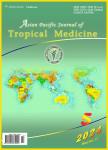Potential applications of lactic acid bacteria and bacteriocins in antimycobacterial therapy
Potential applications of lactic acid bacteria and bacteriocins in antimycobacterial therapy作者机构:Centre for Drug Discovery and Development Sathyabama Institute of Science and Technology
出 版 物:《Asian Pacific Journal of Tropical Medicine》 (亚太热带医药杂志(英文版))
年 卷 期:2018年第11卷第8期
页 面:453-459页
核心收录:
学科分类:1006[医学-中西医结合] 1002[医学-临床医学] 10[医学] 100602[医学-中西医结合临床]
基 金:supported by Sathyabama Institute of Science and Technology Chennai Tamil Nadu India and Indian Council of Medical Research(ICMR) New Delhi India(Ref.No:5/8/5/19/2014-ECD-I)
主 题:Bacteriocin Lactic acid bacteria Antimycobacterial peptides Tuberculosis Immunomodulation Hybrid bacteriocin
摘 要:Tuberculosis(TB) is a communicable disease caused by Mycobacterium tuberculosis(M. tuberculosis). WHO estimated that 10.4 million new(incident) TB cases worldwide in year 2016. The increased prevalence of drug resistant strains and side effects associated with the current anti-tubercular drugs make the treatment options more complicated. Hence, there are necessities to identify new drug candidates to fight against various sub-populations of M. tuberculosis with less or no toxicity/side effects and shorter treatment duration. Bacteriocins produced by lactic acid bacteria(LAB) attract attention of researchers because of its Generally recognized as safe status. LAB and its bacteriocins possess an effective antimicrobial activity against various bacteria and fungi. Interestingly bacteriocins such as nisin and lacticin 3147 have shown antimycobacterial activity in vitro. As probiotics, LAB plays a vital role in promoting various health benefits including ability to modulate immune response against various infectious diseases. LAB and its metabolic products activate immune system and thereby limiting the M. tuberculosis pathogenesis. The protein and peptide engineering techniques paved the ways to obtain hybrid bacteriocin derivatives from the known peptide sequence of existing bacteriocin. In this review, we focus on the antimycobacterial property and immunomodulatory role of LAB and its metabolic products. Techniques for large scale synthesis of potential bacteriocin with multifunctional activity and enhanced stability are also discussed.



